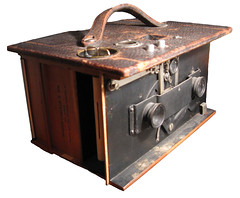Difference between revisions of "No. 2 Stereo Kodak"
(→References) |
Rebollo fr (talk | contribs) (link layout) |
||
| Line 1: | Line 1: | ||
| − | |||
<div style="float: right; border: 1px solid rgb(206, 242, 224); background-color: rgb(245, 245, 255); width: 496px; padding: 0.2em; tect-align: center;"> | <div style="float: right; border: 1px solid rgb(206, 242, 224); background-color: rgb(245, 245, 255); width: 496px; padding: 0.2em; tect-align: center;"> | ||
<p style="border: 1px solid rgb(163, 191, 177); margin: 0pt; padding: 0.2em 0.4em; background-color: rgb(206, 206, 224); font-size: 120%; font-weight: bold; text-align: center; color: rgb(0, 0, 0);">No. 2 Stereo Kodak</p><center> | <p style="border: 1px solid rgb(163, 191, 177); margin: 0pt; padding: 0.2em 0.4em; background-color: rgb(206, 206, 224); font-size: 120%; font-weight: bold; text-align: center; color: rgb(0, 0, 0);">No. 2 Stereo Kodak</p><center> | ||
| Line 19: | Line 18: | ||
Manufactured by the [[Eastman Kodak]], this camera was patented at least four separate times; May 5, 1885, December 1, 1891; Sept. 25, 1894 and January 12, 1897. | Manufactured by the [[Eastman Kodak]], this camera was patented at least four separate times; May 5, 1885, December 1, 1891; Sept. 25, 1894 and January 12, 1897. | ||
| − | The No. 2 Stereo Kodak camera was on the market from 1901 to 1905 and sold for 15 | + | The No. 2 Stereo Kodak camera was on the market from 1901 to 1905 and sold for $15, its design echoes the [[No. 2 Bulls-Eye]], but is larger in width to accommodate the twin rectilinear lenses which made the stereo photographic feature possible. This camera could also be used as a single lens camera by sliding a cap over one lens. |
| − | The No. 2 Stereo Kodak camera is a roll film camera that uses paper-backed 101 film that produces six 3 ½ | + | The No. 2 Stereo Kodak camera is a roll film camera that uses paper-backed 101 film that produces six 3 ½ ” × 6 ” images per roll. Features include two red windows for the number indicators of the film, a timed-shot shutter button, tripod attachment and spirit level. |
| − | ==References== | + | == References == |
| − | http://www.kodak.com/global/en/consumer/products/techInfo/aa13/aa13pg2.shtml | + | * [http://www.kodak.com/global/en/consumer/products/techInfo/aa13/aa13pg2.shtml History of Kodak cameras] in [http://www.kodak.com/ Kodak's official website] |
| − | http://www.historiccamera.com/cgi-bin/librarium/pm.cgi?action=display&login=no2stereokodak | + | * [http://www.historiccamera.com/cgi-bin/librarium/pm.cgi?action=display&login=no2stereokodak No.2 Stereo Kodak Camera] at [http://www.historiccamera.com/ Historic Camera] |
Revision as of 17:22, 4 October 2010
The No. 2 Stereo Kodak Camera was the first stereo camera manufactured by the Eastman Kodak Company. Manufactured by the Eastman Kodak, this camera was patented at least four separate times; May 5, 1885, December 1, 1891; Sept. 25, 1894 and January 12, 1897.
The No. 2 Stereo Kodak camera was on the market from 1901 to 1905 and sold for $15, its design echoes the No. 2 Bulls-Eye, but is larger in width to accommodate the twin rectilinear lenses which made the stereo photographic feature possible. This camera could also be used as a single lens camera by sliding a cap over one lens.
The No. 2 Stereo Kodak camera is a roll film camera that uses paper-backed 101 film that produces six 3 ½ ” × 6 ” images per roll. Features include two red windows for the number indicators of the film, a timed-shot shutter button, tripod attachment and spirit level.

